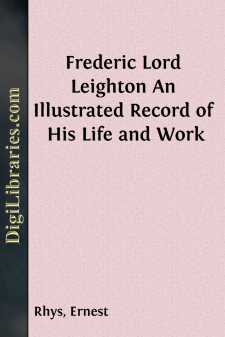Categories
- Antiques & Collectibles 13
- Architecture 36
- Art 48
- Bibles 22
- Biography & Autobiography 813
- Body, Mind & Spirit 142
- Business & Economics 28
- Children's Books 15
- Children's Fiction 12
- Computers 4
- Cooking 94
- Crafts & Hobbies 4
- Drama 346
- Education 46
- Family & Relationships 57
- Fiction 11828
- Games 19
- Gardening 17
- Health & Fitness 34
- History 1377
- House & Home 1
- Humor 147
- Juvenile Fiction 1873
- Juvenile Nonfiction 202
- Language Arts & Disciplines 88
- Law 16
- Literary Collections 686
- Literary Criticism 179
- Mathematics 13
- Medical 41
- Music 40
- Nature 179
- Non-Classifiable 1768
- Performing Arts 7
- Periodicals 1453
- Philosophy 64
- Photography 2
- Poetry 896
- Political Science 203
- Psychology 42
- Reference 154
- Religion 513
- Science 126
- Self-Help 84
- Social Science 81
- Sports & Recreation 34
- Study Aids 3
- Technology & Engineering 59
- Transportation 23
- Travel 463
- True Crime 29
Frederic Lord Leighton An Illustrated Record of His Life and Work
by: Ernest Rhys
Categories:
Description:
Excerpt
His Early Years
To Italy, at whose liberal well-head English Art has so often renewed itself, we turn naturally for an opening to this chronicle of a great English artist's career. Frederic Leighton was the painter of our time who strove hardest to keep alive an Italian ideal of beauty in London; therefore it is in Italy, the Italy of Raphael and Angelo and his favourite Giotteschi, that we must seek the true beginnings of his art.
London made its first acquaintance with him and his painting in 1855, when the picture, Cimabue's Madonna carried in Procession through the Streets of Florence, startled the Royal Academy, and proved that a 'prentice work could be in its way something of a masterpiece. This picture, the work of an unknown young artist of twenty-five, painted chiefly in Rome, showed at once a new force and a new quality, and in its singular feeling for certain of the archaic Italian schools, showed, too, where for the moment the sympathies of the painter really lay. How far the potentiality disclosed in it was developed during the forty years following, how far the ideals in art, which it seemed to declare, were pursued or departed from, the Royal Academy year by year is witness. Here, before we turn to consider the history of those later years, we shall find it interesting to use this first picture as an index to that period of probation, which is so often the most interesting part of an artist's history. In accounting for it, and finding out the determining experiences of the artist's pupilage, we shall account, also, for much that came after. Although Frankfort and Paris play their part, the formative influences of that early period, we shall find, carry us chiefly, and again and again, into Italy.
Frederic Leighton was born on the 3rd of December, 1830, at Scarborough, the son of a medical practitioner. His father, Dr. Frederic Leighton, was also the son of a physician who was knighted for eminence in his profession. Thus we have two generations of medicine and culture in the family; but there is no sign of art, or love for art, before the third. This generation produced three children, all devoted to the graphic arts and to music, of whom the boy, Frederic was the eldest.
A word or two more must be given to his forbears, on grounds of character and heredity, before we pass. Sir James Leighton, the grandfather, was Physician to the Court at St. Petersburg, where he served in succession Alexander the First, and Nicholas, with whom he was on terms of considerable intimacy. His son, Dr. Frederic Leighton, who promised to be a still more brilliant practioner, was educated at Stonyhurst, but after taking his M.D. degree at Edinburgh, just as he was rapidly acquiring the highest professional reputation, contracted a cold that led to a partial deafness. This made it impossible for him to go on practising with safety, and retiring to his study he turned from physical to metaphysical pursuits. In spite of his deafness, as severe an embargo on social reputation as can well be laid, Dr....




